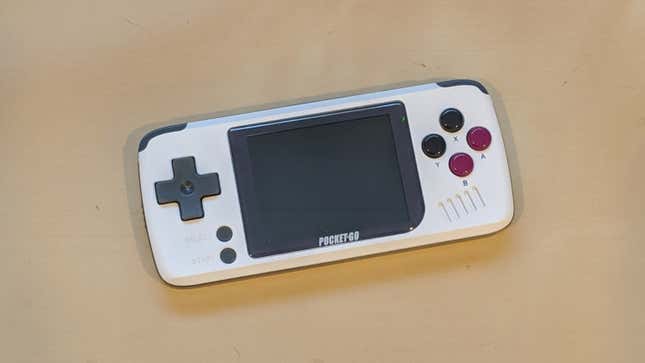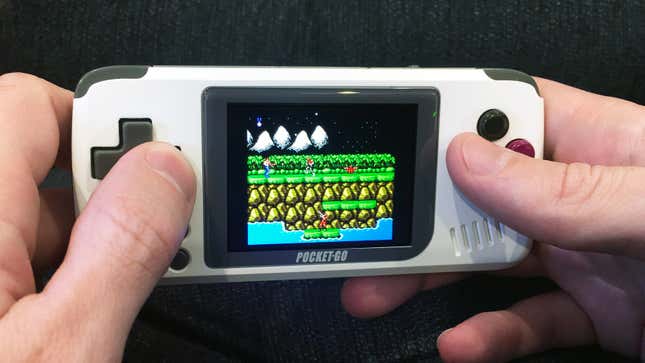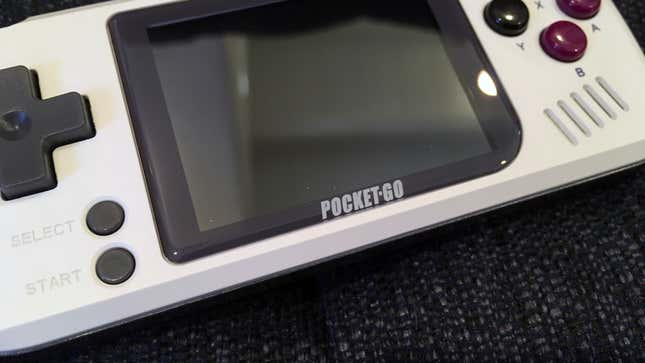
Everyone has that book they read once a year, or the movie they watch over and over again as a piece of “comfort media.” Ever since I was seven years old, mine has been Super Mario World for the Super Nintendo.
I’ve lost count of how many times I played that game as a kid. As the years wore on, my Super NES lost its position in my TV’s inputs to newer consoles and DVD players, but thanks to the magic of emulation, I still relive my favorite childhood game every year or two on my PC.
But the next time I play through it, it’s going to be on the Bittboy PocketGo.
Note: I purchased mine on Amazon, but if it’s not in stock there, you can also get it from AliExpress.
There have been dozens of ways to emulate retro games on a handheld over the years. You could hack your PSP or Nintendo 3DS, use your phone coupled with a Gamevice, or buy one of many handheld retro emulation devices on the market. The PocketGo is one such device, and while it isn’t the most powerful retro gaming machine in the world, you can get it for under $40—which means it offers a “fun per dollar” ratio that’s tough to match.
While most handhelds sit just this side of “Cargo Pants Required,” the Pocket Go stays true to its name: it’s very small, only about 4.8" x 2.2" x 0.5", designed to slip right into your pocket or purse like that old Nokia cell phone you used to have. While it’s shaped somewhat like a tiny Game Boy Advance, its color scheme is a dead ringer for the original Game Boy—though it comes with Super Famicom-themed buttons you can swap in yourself. I found it easy to play despite its small size, though folks with larger hands may find it a bit too diminutive. The buttons have a satisfying click and the 2.4-inch IPS screen—while small—is bright and beautiful, with a 320×240 resolution and a 30Hz refresh rate (okay, that last part is somewhat disappointing, and we’ll come back to it in a moment). There is a version 2 now available, but it’s significantly larger and a bit more expensive, which for me, sort of defeats the purpose.

Out of the box, the PocketGo comes with emulators for the Atari 2600, various Game Boys, Nintendo, Super Nintendo, PlayStation, and a few others built in. It also comes with a number of freeware and classic shareware PC games like Doom, Quake, and Cave Story—though games like Doom only contain the shareware levels, and you’ll have to add the rest yourself if you own the game. The good news is that everything’s stored on a microSD card, so you can pop it into your PC, copy over your favorite ROMs, add some Doom WADs, and have a killer little system going.
The PocketGo advertises 3-4 hours of battery life, and I regularly found myself getting the top end of that range (if not closer to 5 hours on some occasions). Of course, this depends on what games you play, how high you set the brightness, and so on, but it’s not too dissimilar from other handheld gaming systems.
There is, however, a catch—or rather, a few catches. At $40, Bittboy had to cut corners somewhere. The hardware is a bit underpowered for a few of the built-in emulators (Super Nintendo and PlayStation being the big ones), which is a bit of a bummer. The out-of-the-box SNES settings run pretty well by default, but that comes with transparency effects turned off. This causes some weird graphical glitches in certain games, some of which are minor annoyances, some of which are game-breaking. You can turn transparency back on in the settings, but unless you want to deal with choppier playback, you’ll have to sacrifice elsewhere, like lowering the sample rate of the audio.

It’s not a deal killer for me by any means, especially given the price, but just know that the PocketGo shines most when emulating handheld systems like Game Boy, but I still find it suitable for casual NES and SNES gaming with those compromises. Heck, even Doom runs pretty darn well. More hardcore emulation enthusiasts, though, will want something like the LDK Horizontal to match their more refined palate. (It’s slightly larger and pricier—at least when you include shipping—at most places, which again, moves away from what I love about the PocketGo.)
The screen, while beautiful, has a similar problem: it’s only 30Hz, which means even if you are getting 60 frames per second in a given game, you aren’t going to be able to see that many frames. It also produces some subtle screen tearing—when the PocketGo first launched, most reviews called this out as a deal-killing problem, but firmware updates seem to have lessened it somewhat, and frankly, with a screen this small, I find myself rarely noticing it (even though I’m pretty sensitive to it on PC monitors and TVs).
There are custom firmware builds out there for the PocketGo that add more emulators, boost performance in certain areas, and otherwise improve the overall experience. They do, however, come at the cost of...well, knowing how to flash your own firmware. If you’ve ever used a Raspberry Pi, it’ll be second nature to you, but more tech-unsavvy users might hit some roadblocks along the way. I tried the latest of these builds and found it to be fine, but ultimately not that important to have a good time. (Certain other things—like ensuring you power it down using the home screen’s “Power Off” option rather just flipping the power switch—might also throw off less tech-savvy users.)

There are also some Quality Control quirks, like dust under the screen (which is fixable, but disappointing nonetheless) and light bleed (which I don’t see on my unit, but is also fixable). I wish a bit more care had been taken with a few of these things, but at the end of the day, for such a cheap device—which is more of a grab-and-go handheld rather than a primary emulation machine—I can’t say any of them are deal breakers for me.
I could go into more detail about how to bend this thing to your will—customizing controls, tweaking the emulator’s clock speed, and futzing with other settings, but this article would get mighty long, and there are already plenty of threads out there with advice already. After playing with it for a few weeks, I don’t feel too much tweaking is necessary to have a good time, but if you want, you can really dig deep into the PocketGo’s software.
That may sound like an awful lot of caveats, but despite the drawacks, I’ve never had this much fun for this little money. You know how they say “The best camera is the one you have with you?” Well, the best portable gaming device is the one I’m most likely to bring with me, and the PocketGo’s size makes it the first device I go to when I’m rushing out of the house. Sure, if you’re a stickler about emulation performance and accuracy, this is definitely not for you. But if you’re a somewhat tech-savvy, casual gamer looking for a cheap handheld that fits anywhere, the PocketGo will serve you well.
Now, if you’ll excuse me, I’m this close to beating the second level of Operation C.